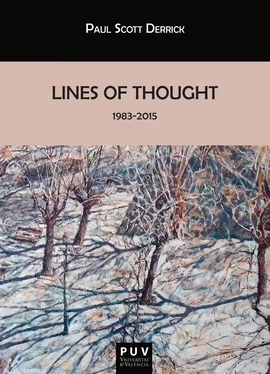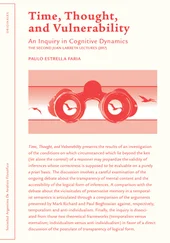Paul Scott Derrick Grisanti - Lines of Thought
Здесь есть возможность читать онлайн «Paul Scott Derrick Grisanti - Lines of Thought» — ознакомительный отрывок электронной книги совершенно бесплатно, а после прочтения отрывка купить полную версию. В некоторых случаях можно слушать аудио, скачать через торрент в формате fb2 и присутствует краткое содержание. Жанр: unrecognised, на английском языке. Описание произведения, (предисловие) а так же отзывы посетителей доступны на портале библиотеки ЛибКат.
- Название:Lines of Thought
- Автор:
- Жанр:
- Год:неизвестен
- ISBN:нет данных
- Рейтинг книги:4 / 5. Голосов: 1
-
Избранное:Добавить в избранное
- Отзывы:
-
Ваша оценка:
- 80
- 1
- 2
- 3
- 4
- 5
Lines of Thought: краткое содержание, описание и аннотация
Предлагаем к чтению аннотацию, описание, краткое содержание или предисловие (зависит от того, что написал сам автор книги «Lines of Thought»). Если вы не нашли необходимую информацию о книге — напишите в комментариях, мы постараемся отыскать её.
Lines of Thought — читать онлайн ознакомительный отрывок
Ниже представлен текст книги, разбитый по страницам. Система сохранения места последней прочитанной страницы, позволяет с удобством читать онлайн бесплатно книгу «Lines of Thought», без необходимости каждый раз заново искать на чём Вы остановились. Поставьте закладку, и сможете в любой момент перейти на страницу, на которой закончили чтение.
Интервал:
Закладка:
LINES OF THOUGHT
1983-2015
Biblioteca Javier Coy d’estudis nord-americans
http://www.uv.es/bibjcoy
Directora
Carme Manuel
LINES OF THOUGHT
1983-2015
Paul Scott Derrick
Biblioteca Javier Coy d’estudis nord-americans
Universitat de València
Lines of Thought: 1983-2015
© Paul Scott Derrick
1ª edición de 2015
Reservados todos los derechos
Prohibida su reproducción total o parcial
ISBN: 978-84-9134-178-9
Imagen de la portada: Ian Sharp, detalle de Plaça Xuquer Series
Diseño de la cubierta: Celso Hernández de la Figuera
Publicacions de la Universitat de València
http://puv.uv.es
publicacions@uv.es
In memory of my sister Rosemary who always gave much more than she received
How this critic thinks, what I look for when I read, and ultimately what I project on a text is a critical method only because I believe there is no critical method except yourself. As women and men of letters, we ought to share in a vision in which the highest literature becomes our way of life.
Harold Bloom,
Only the Daemon Knows
[H]ow can science, when it is based on a fragmentary attitude to life, ever understand the essence of real problems that depend on an indefinitely wide context? The answer does not lie in the accumulation of more and more knowledge. What is needed is wisdom . It is a lack of wisdom that is causing most of our serious problems rather than a lack of knowledge.
David Bohm and F. David Peat,
Science, Order, and Creativity
TABLE OF CONTENTS
Acknowledgements Acknowledgements I would like to acknowledge the editors of all the journals and other collections in which the essays republished here originally appeared. Those volumes are identified in a note appended to each of the titles that follow. I also want to thank the co-authors of two of these essays, Juan López Gavilán and Guillermo Peris Bautista, as well as the translators of several others: Jesús Tronch Pérez (“Emily Dickinson’s Epistemological Abstinence”), Juan López Gavilán (“Sarah Orne Jewett and The Country of the Pointed Firs ”), Miguel Teruel Pozas (“An Unexpected European Voice”) and Marie Chabbert (“ Manual : All Hands Clapping”). In these and other projects, my time with them has always been both pleasurable and personally enriching. This kind of amiable collaboration between colleagues is one of the privileges of working in a university environment. And finally, my gratitude to Carme Manuel, head of the Biblioteca Javier Coy, for making this book possible and for her support, encouragement and friendship during many years at the Universitat de València.
Foreword
I EMERSON, DICKINSON, HEIDEGGER
Emily Dickinson, Martin Heidegger and the Poetry of Dread
Heart Is Where the Home Is. Some Reflections on the Line between Wisdom and Knowledge
Emerson? In the Classroom? A Few Considerations on an Emersonian Model of Learning
What the Mirror Sees: Reflection and Wholeness in Emerson and Heidegger
Emily Dickinson’s Epistemological Abstinence
Dickinson, Doubt and the Skeptical Argument: Notes for a Defense of the Unspoken
II JEWETT, BURROUGHS AND PYNCHON, STEELE
Sarah Orne Jewett and The Country of the Pointed Firs
Language, Control and the Paradigm Shift in the Fiction of William S. Burroughs and Thomas Pynchon
A New Organicism. Language, Form and Flux in Timothy Steele’s “Profils Perdus”
III BERENGARTEN
An Unexpected European Voice
A Poet for a Time of Need
Manual : All Hands Clapping
Acknowledgements
I would like to acknowledge the editors of all the journals and other collections in which the essays republished here originally appeared. Those volumes are identified in a note appended to each of the titles that follow.
I also want to thank the co-authors of two of these essays, Juan López Gavilán and Guillermo Peris Bautista, as well as the translators of several others: Jesús Tronch Pérez (“Emily Dickinson’s Epistemological Abstinence”), Juan López Gavilán (“Sarah Orne Jewett and The Country of the Pointed Firs ”), Miguel Teruel Pozas (“An Unexpected European Voice”) and Marie Chabbert (“ Manual : All Hands Clapping”). In these and other projects, my time with them has always been both pleasurable and personally enriching. This kind of amiable collaboration between colleagues is one of the privileges of working in a university environment.
And finally, my gratitude to Carme Manuel, head of the Biblioteca Javier Coy, for making this book possible and for her support, encouragement and friendship during many years at the Universitat de València.
Foreword
This book brings together twelve essays published during the span of years contained in its title: 1983-2015. To a certain extent, therefore, they reflect the evolution over more than three decades in my thinking about several of the authors that have maintained my interest and admiration for much of my life as a student, teacher and lover of literature.
I use the word “evolution” carefully, rather than the first word—“growth”—that came to mind as I wrote the previous sentence. For if you compare the earliest and most recent of the essays that follow you may conclude that my thinking has not grown at all. I do hope, though, that it might be perceived to have broadened and deepened.
The principal “line of thought” that unites this otherwise disparate collection of essays is the one that I had only vaguely begun to glimpse in my early and unending fascination with the poetry of Emily Dickinson. I didn’t see it when I wrote “Emily Dickinson, Martin Heidegger and the Poetry of Dread” because at that time I had not yet begun to study and ruminate on Emerson’s profound assimilation of romantic ideas for the benefit of the newly-emerging American character. I thought, then, that I had done enough in feeling out the unintended resonances between the amazing mind of a 19 th-century American hermit-poet and a 20 th-century German existential philosopher.
But as time went by, I gradually came to realize that I was describing what I now understand to be the central—albeit recessive—thread of American (and western) thought. It takes shape, from its European antecedents, in Emerson, passes through Thoreau, Whitman and Dickinson, doubles back to Europe in the thinking of Nietzsche and Heidegger and opens out in myriad forms through the 20 thand 21 stcenturies, finding one of its most lucid contemporary expositors in Stanley Cavell.
Perhaps I should stress that I am not talking only about a linear series of causal influences, but a deeper general current of concepts and attitudes that underpin our culture and contribute to the way we formulate our images of what we are. It can be found, of course, in many more figures than those I name and discuss here.
It is true that the spiritual (i.e., non-materialistic) component of what we might think of as the original American aspiration was radically secularized over the course of the second half of the 19 thcentury. As American life became more and more absorbed with both physical and economic expansion, the essentially romantic nature of our evolving character was pushed farther and farther into the background. But it did not disappear. It has always been there, most notably in the works of a large number of our finest artists. I am not alone in sustaining that the best American art is always subversive. That subversive thrust can take on many forms, but the main one is probably a resistance to the ever-growing power of materialistic values, in all of their various guises, in the life of the United States.
Читать дальшеИнтервал:
Закладка:
Похожие книги на «Lines of Thought»
Представляем Вашему вниманию похожие книги на «Lines of Thought» списком для выбора. Мы отобрали схожую по названию и смыслу литературу в надежде предоставить читателям больше вариантов отыскать новые, интересные, ещё непрочитанные произведения.
Обсуждение, отзывы о книге «Lines of Thought» и просто собственные мнения читателей. Оставьте ваши комментарии, напишите, что Вы думаете о произведении, его смысле или главных героях. Укажите что конкретно понравилось, а что нет, и почему Вы так считаете.












